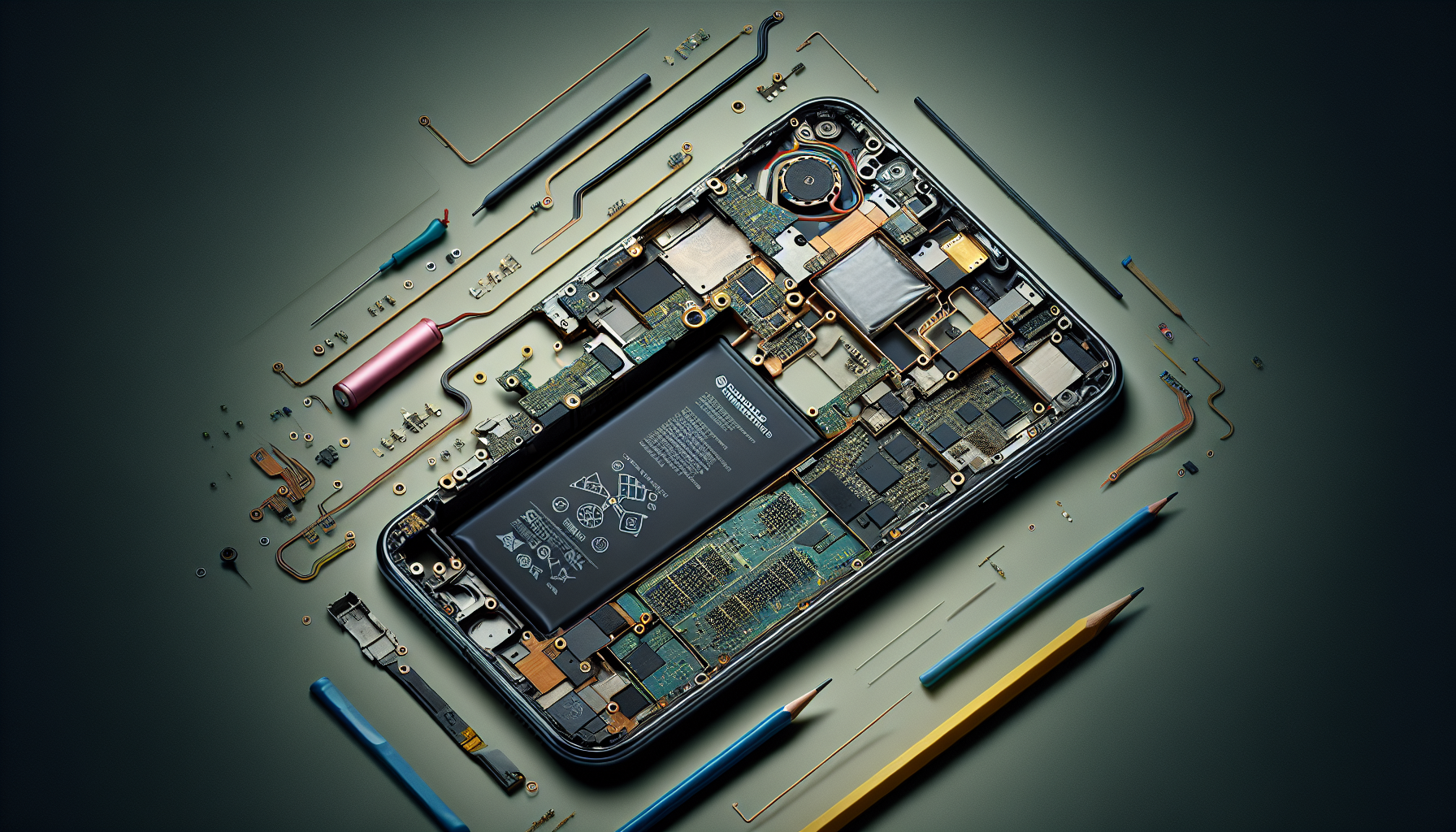Have you ever wondered what goes on behind the scenes of your phone? How it functions and the intricate details that make it work seamlessly? Look no further! This article serves as the ultimate guide to in-depth phone analysis, where we will explore the inner workings of your device, uncover its secrets, and provide you with a comprehensive understanding of how your phone operates. Get ready to embark on a fascinating journey of discovery as we unveil the mysteries of your beloved gadget.
Understanding the Importance of Phone Analysis
As technology continues to advance at a rapid pace, our reliance on smartphones has become more prevalent than ever. These devices store a wealth of information, making them a goldmine of valuable evidence in investigative work. Phone analysis plays a crucial role in extracting and examining this information, shedding light on important details that can help solve cases and bring justice to those who need it.
The Role of Phone Analysis in Investigative Work
When it comes to investigative work, phone analysis is an invaluable tool. It allows investigators to gain access to a wide range of information that can be crucial in solving cases. By examining call logs, messages, internet history, social media activity, and installed applications, analysts can piece together a timeline of events, establish connections between individuals, and even uncover deleted or hidden data.
Furthermore, the examination of physical aspects of the phone, such as the condition of the screen, buttons, and battery components, can provide important clues about the phone’s usage and history. Additionally, digging into phone forensics allows analysts to understand file systems, storage, and metadata, enabling the recovery of deleted files and identification of potential malware or suspicious activities.
Benefits of Conducting a Thorough Phone Analysis
By conducting a thorough phone analysis, investigators can reap several benefits. Firstly, it allows for a comprehensive understanding of the evidence at hand. By examining call logs, messages, and internet history, investigators can gain insights into the communication patterns and activities of the individuals involved in the case. This understanding is essential when it comes to establishing motive, identifying potential accomplices, or unraveling the truth behind complex scenarios.
Furthermore, phone analysis enables the identification of potential security breaches. By analyzing permissions, privacy settings, and system logs, analysts can detect vulnerabilities, identify malicious software, and assess the effectiveness of security measures. This knowledge is crucial in securing digital systems and preventing future breaches.
In addition to its investigative benefits, phone analysis also plays an important role in legal proceedings. By interpreting the findings and preparing comprehensive reports, analysts can provide valuable evidence that can be presented in court. This evidence is often crucial in supporting or refuting claims, ultimately aiding the judicial process.
Preparing for Phone Analysis
Before diving into the world of phone analysis, it is important to be adequately prepared. This involves gathering the necessary tools and equipment, securing the phone and data, and setting up a controlled environment to ensure accurate and reliable analysis.
Gathering Necessary Tools and Equipment
To conduct a thorough phone analysis, it is important to have the right tools and equipment at your disposal. This includes forensic software, cables and connectors, SIM card readers, and specialized hardware for physical extraction if required. These tools are essential in effectively extracting and examining the data stored on the phone.
Securing the Phone and Data
When dealing with sensitive information, it is crucial to take steps to secure the phone and data during the analysis process. This involves ensuring that the phone is stored in a secure location, protected from physical damage or tampering. Additionally, it is important to make copies or create forensic images of the phone’s content to prevent any accidental or intentional data loss during the analysis.
Setting Up a Controlled Environment
To ensure accurate and reliable analysis, it is recommended to set up a controlled environment for phone analysis. This includes working in a clean and organized space, free from any distractions or potential sources of contamination. Additionally, it is important to document and maintain a clear chain of custody to ensure the integrity of the evidence.

Examining the Physical Aspects
When starting the phone analysis process, it is essential to thoroughly examine the physical aspects of the phone. This involves inspecting the exterior of the phone, checking the condition of the screen, examining the buttons and controls, and assessing the battery and power components.
Inspecting the Exterior of the Phone
By carefully inspecting the exterior of the phone, analysts can gather valuable information about its usage and history. Scratches, dents, or signs of damage can indicate how the phone was handled and potentially provide insights into the circumstances surrounding the case. Additionally, examining any stickers, labels, or adhesive residue can help in identifying potential modifications or tampering.
Checking the Condition of the Screen
The condition of the screen can provide important clues about the phone’s usage and potential damage. Scratches, cracks, or discoloration can indicate the level of wear and tear the phone has experienced. Moreover, examining the screen can help identify potential tampering or attempts to remove evidence.
Examining the Buttons and Controls
Analyzing the buttons and controls of the phone is another crucial step in the analysis process. By checking for any damage, unusual wear patterns, or missing components, analysts can gain insights into how the phone was used and potentially find evidence related to the case. Additionally, buttons and controls can hold fingerprints or DNA, which can be valuable for further investigations.
Assessing the Battery and Power Components
The battery and power components of a phone can reveal important information about the phone’s usage patterns and history. By assessing the battery’s condition, charge cycles, and capacity, analysts can gain insights into the phone’s active usage and potential periods of inactivity. Additionally, examining the power components can help in identifying any modifications or tampering attempts.
Performing Software Analysis
Once the physical examination is complete, it is time to delve into the world of software analysis. This involves establishing a forensic image, extracting data using forensic software, analyzing call logs and messages, examining internet history and social media activity, investigating installed applications, and recovering deleted or hidden data.
Establishing a Forensic Image
Before proceeding with any software analysis, it is essential to establish a forensic image of the phone’s storage. This involves creating an exact replica of the phone’s data, ensuring that no changes are made to the original evidence. By creating a forensic image, analysts can work with a copy of the data without altering or compromising the original source.
Extracting Data Using Forensic Software
With the forensic image in hand, analysts can employ specialized forensic software to extract and examine the data stored on the phone. This software provides powerful tools and techniques for accessing the phone’s content, including call logs, messages, media files, and application data. By leveraging these tools, analysts can retrieve crucial evidence that may otherwise be inaccessible.
Analyzing Call Logs and Messages
Call logs and messages are a treasure trove of valuable information in phone analysis. By examining these communication records, analysts can establish connections between individuals, identify key players in the case, and even uncover potential motives. The analysis of call logs and messages can provide insights into the timing, frequency, and content of communications, helping investigators establish a timeline of events.
Examining Internet History and Social Media Activity
In today’s digital age, internet history and social media activity can provide powerful insights into a person’s behavior, interests, and associations. By analyzing the internet history and social media activity of the phone’s user, analysts can uncover valuable evidence related to the case. This analysis can help identify potential accomplices, uncover hidden motives, or verify alibis.
Investigating Installed Applications
The installed applications on a phone can provide valuable insights into a user’s activities, interests, and communications. By investigating the installed applications, analysts can uncover evidence related to conversations, transactions, or other activities that may be relevant to the case. This analysis can help establish connections between individuals, gather additional evidence, or provide context to the overall investigation.
Recovering Deleted or Hidden Data
In some cases, valuable evidence may have been intentionally deleted or hidden on the phone. However, through sophisticated forensic techniques, analysts can often recover this data. By utilizing specialized tools and methodologies, analysts can access deleted files, hidden folders, or overwritten data. This recovery of deleted or hidden data can provide crucial evidence that may have been thought to be lost forever.

Digging into Phone Forensics
Phone forensics delves deeper into the underlying technical aspects of the phone’s storage and system. Understanding file systems and storage, analyzing metadata and system logs, reconstructing deleted files, and identifying malware or suspicious activities are key components of this phase of phone analysis.
Understanding File Systems and Storage
To effectively analyze a phone’s storage, it is important to understand the underlying file systems and storage architecture. Different phone models use different file systems, such as FAT, NTFS, or EXT4. By familiarizing themselves with these file systems, analysts can navigate and access the relevant data more efficiently. Understanding storage allocation, file fragments, and file system artifacts is crucial to ensure a comprehensive analysis.
Analyzing Metadata and System Logs
Metadata and system logs provide valuable information about the phone’s usage and activities. By analyzing metadata associated with files, such as timestamps, geolocation tags, or user identifiers, analysts can gain insights into when and how files were created, modified, or accessed. Additionally, examining system logs can reveal important information about the phone’s activities, including network connections, app usage, or system errors.
Reconstructing Deleted Files
Deleted files are not always permanently erased from a phone’s storage. By employing advanced forensic techniques, analysts can often reconstruct deleted files. By analyzing residual data, file fragments, or temporary storage areas, analysts can recover valuable evidence that may have been thought to be lost. This reconstruction of deleted files can be instrumental in unraveling complex cases or uncovering critical evidence.
Identifying Malware or Suspicious Activities
As smartphones become increasingly connected to the digital world, the risk of malware and suspicious activities rises. Phone forensics involves identifying potential malware or security breaches on the phone. By analyzing system logs, app permissions, and network activities, analysts can identify any indicators of compromise. This analysis is essential in uncovering potential threats and assessing the overall security of the phone and its data.
Analyzing Phone Network Connections
Phone network connections play a vital role in phone analysis. By tracking and analyzing cellular network data, examining Wi-Fi connections and settings, investigating Bluetooth connections, and analyzing GPS and location data, analysts can gain valuable insights into the phone’s activities and potential associations.
Tracking and Analyzing Cellular Network Data
Cellular network data can provide valuable information about a phone’s location, usage patterns, and connections. By tracking and analyzing this data, analysts can determine the phone’s movements, the towers it has connected to, and potentially establish an individual’s whereabouts during certain events. This analysis can be instrumental in corroborating or refuting alibis, establishing timelines, or identifying potential witnesses.
Examining Wi-Fi Connections and Settings
Wi-Fi connections and settings can reveal important details about a phone’s activities and associations. By examining the Wi-Fi connections that the phone has connected to, analysts can identify potential Wi-Fi networks used by the phone’s user. This analysis can provide insights into the locations visited, potentially uncover hidden activities, or identify connections to specific networks that may be of interest to the investigation.
Investigating Bluetooth Connections
Bluetooth connections can also provide valuable information in phone analysis. By investigating Bluetooth connections, analysts can determine potential devices that the phone has been paired with. This analysis can help establish associations between individuals or identify devices that may have been used during the commission of a crime. Identification of Bluetooth connections can be crucial in piecing together the overall puzzle of the case.
Analyzing GPS and Location Data
GPS and location data are key components of modern smartphones. By analyzing this data, analysts can determine the phone’s precise location at certain times, track movements, and potentially establish links to specific events or locations. Whether it’s determining if a suspect was at the scene of a crime or corroborating witness testimonies, analyzing GPS and location data can be pivotal in investigations.

Uncovering Potential Security Breaches
Ensuring the security of digital systems is paramount in phone analysis. By identifying vulnerabilities and exploits, detecting spyware or malicious software, analyzing permissions and privacy settings, and assessing the effectiveness of security measures, analysts can help prevent future breaches and protect sensitive data.
Identifying Vulnerabilities and Exploits
To ensure the security of a phone and its data, it is important to identify potential vulnerabilities and exploits. By analyzing the phone’s software, system updates, and known vulnerabilities, analysts can assess the level of risk and recommend appropriate security measures. This analysis involves staying up-to-date with the latest trends in software vulnerabilities and exploring potential avenues of exploitation.
Detecting Spyware or Malicious Software
Spyware and malicious software pose a significant threat to the security of a phone and the privacy of its user. By employing specialized tools and techniques, analysts can detect the presence of spyware or malicious software on the phone. This analysis involves scanning for suspicious files, monitoring system logs for unusual activities, and evaluating app permissions to identify any potential risks.
Analyzing Permissions and Privacy Settings
Permissions and privacy settings play a crucial role in ensuring the security of a phone. By analyzing the permissions granted to installed applications and evaluating the phone’s privacy settings, analysts can identify potential risks or breaches. This analysis can provide insights into the level of access granted to applications and allow for the adjustment of settings to enhance security.
Assessing the Effectiveness of Security Measures
Phone manufacturers and software developers constantly strive to improve the security of their devices and applications. By assessing the effectiveness of the security measures implemented on the phone, analysts can provide valuable feedback to manufacturers and users alike. This analysis involves evaluating encryption protocols, authentication mechanisms, and other security features to ensure their robustness and effectiveness.
Interpreting Phone Analytical Findings
The process of phone analysis often yields a significant amount of data and information. To make sense of the findings, it is crucial to interpret the analysis comprehensively. This involves correlating data for comprehensive analysis, identifying patterns or anomalies, drawing conclusions and implications, and preparing findings for legal proceedings.
Correlating Data for Comprehensive Analysis
Correlating data from various sources is key to conducting a comprehensive analysis. By combining findings from call logs, messages, internet history, social media activity, and other sources, analysts can paint a more complete picture of the events and individuals involved in the case. This correlation allows for a deeper understanding of the evidence and helps establish a coherent narrative.
Identifying Patterns or Anomalies
Analyzing phone data often reveals patterns or anomalies that may not be immediately apparent. By carefully examining the data, analysts can identify recurring behaviors, trends, or inconsistencies that may shed light on the case. These patterns or anomalies can be instrumental in uncovering hidden connections, revealing potential motives, or identifying areas that require further investigation.
Drawing Conclusions and Implications
Once the data has been thoroughly analyzed and patterns have been identified, analysts can draw conclusions and implications based on the evidence. This step involves synthesizing the findings, assessing their relevance and weight, and formulating a coherent narrative that supports or refutes the claims in the case. Drawing accurate conclusions and implications is crucial in providing valuable insights to investigators, legal teams, and the judicial system.
Preparing Findings for Legal Proceedings
The findings from phone analysis often play a pivotal role in legal proceedings. To ensure their reliability and admissibility, it is important to prepare the findings properly. This includes documenting the analysis process, maintaining a clear chain of custody, and presenting the findings in a clear, concise, and unbiased manner. Well-prepared findings are essential in supporting or refuting claims, providing evidence, and aiding in the pursuit of justice.

Ensuring Legal and Ethical Considerations
Phone analysis must be conducted with strict adherence to laws and regulations, while also protecting user privacy and data. This involves adhering to legal requirements, ensuring proper consent and authorization, and working in conjunction with law enforcement agencies.
Adhering to Laws and Regulations
Phone analysis is subject to various laws and regulations that govern the handling of digital evidence. It is essential for analysts to be aware of and adhere to these laws to ensure the integrity and admissibility of their findings. This includes familiarizing themselves with laws regarding data privacy, digital forensics, and the admissibility of evidence in their respective jurisdictions.
Protecting User Privacy and Data
Respecting user privacy and protecting sensitive data is of utmost importance in phone analysis. Analysts must handle and store personal data with care, ensuring that it is not compromised or shared inappropriately. It is vital to implement strict data protection measures, including encryption, secure storage, and proper data disposal practices.
Obtaining Proper Consent and Authorization
Before conducting any phone analysis, it is important to obtain proper consent and authorization from the relevant parties. This may involve obtaining a search warrant or written consent from the phone’s owner or authorized parties. Properly documenting and maintaining records of consent and authorization is crucial to ensure the legality and validity of the analysis.
Working in Conjunction with Law Enforcement Agencies
Phone analysis often goes hand in hand with criminal investigations. It is essential to work in conjunction with law enforcement agencies, sharing findings and collaborating on the case. By aligning efforts and expertise, analysts can provide valuable support to the investigative process and ensure that their findings are integrated seamlessly into the legal proceedings.
Enhancing Phone Analysis Skills
To excel in phone analysis, it is crucial to continuously enhance skills and stay updated with the latest techniques and tools. This involves continuing education in digital forensics, staying abreast of advancements in technology, practicing hands-on phone analysis, and joining professional networks and organizations.
Continuing Education in Digital Forensics
The field of digital forensics is constantly evolving, with new techniques, tools, and challenges emerging regularly. To stay at the forefront of the field, analysts should engage in continuing education and professional development. This can include attending workshops, conferences, or training courses focused on digital forensics, where new methodologies and best practices are shared.
Staying Updated with Latest Techniques and Tools
As technology progresses, new tools and techniques are developed to aid in phone analysis. It is essential for analysts to stay updated with the latest advancements in this field. Keeping a close eye on industry publications, academic research, and emerging technologies ensures that analysts can leverage the most effective tools and techniques to enhance their analysis.
Practicing Hands-on Phone Analysis
Phone analysis, like any skill, requires practice to master. By regularly practicing hands-on phone analysis, analysts can refine their techniques, familiarize themselves with different phone models and operating systems, and gain a deeper understanding of the intricacies involved. This can involve creating mock scenarios, working on sample cases, or participating in training exercises.
Joining Professional Networks and Organizations
Actively engaging in professional networks and organizations in the field of digital forensics can provide valuable opportunities for learning and growth. By joining associations and participating in discussions and forums, analysts can connect with peers, share knowledge, and stay updated with the latest trends and challenges. This collaboration and networking enable analysts to enhance their skills and broaden their perspectives.
In conclusion, in-depth phone analysis is a pivotal component of modern investigative work. By thoroughly examining the physical aspects, performing software analysis, digging into phone forensics, analyzing phone network connections, uncovering potential security breaches, interpreting findings, ensuring legal and ethical considerations, and continuously enhancing skills, analysts can unlock valuable evidence, support legal proceedings, and contribute to the pursuit of justice.




